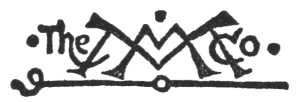Transcriber’s Notes
Obvious typographical errors have been silently corrected. Variationsin hyphenation have been standardised but all other spelling,punctuation and accents remains unchanged.
The repetition of section titles on consecutive pages has been removed.
A reference to Monism as “destructive of culture, etc.” in the indexto page 450, which does not exist, has been changed to 350.
THE CASE AGAINST EVOLUTION

THE MACMILLAN COMPANY
NEW YORK · BOSTON · CHICAGO · DALLAS
ATLANTA · SAN FRANCISCO
MACMILLAN & CO., Limited
LONDON · BOMBAY · CALCUTTA
MELBOURNE
THE MACMILLAN CO. OF CANADA, Ltd.
TORONTO
THE CASE AGAINST
EVOLUTION
BY
GEORGE BARRY O’TOOLE, Ph. D., S.T.D.
PROFESSOR OF THEOLOGY AND PROFESSOR EMERITUS OF PHILOSOPHY,
ST. VINCENT ARCHABBEY; PROFESSOR OF ANIMAL
BIOLOGY, SETON HILL COLLEGE
New York
THE MACMILLAN COMPANY
1926
All rights reserved
Copyright, 1925,
By THE MACMILLAN COMPANY.
Set up and electrotyped.
Published April, 1925.
Reprinted February, 1926.
Printed in the United States of America by
J. J. LITTLE AND IVES COMPANY, NEW YORK
TO MY MOTHER
ADDENDA
Note to page 23.—
As a result of recent investigations on the sex chromosomes andchromosome numbers in mammals, Theophilus S. Painter reaches theconclusions that polyploidy cannot be invoked to explain evolutionwithin this class. After giving a table of chromosome numbers for7 out of the 9 eutherian orders, Painter concludes: “The facts recordedabove are of especial interest in that they indicate a unity of chromosomecomposition above the marsupial level and effectively dispose ofthe suggestion that extensive polyploidy may have occurred within thissubclass.
“In the marsupials the chromosome number is a low one and in theopossum is 22. At first sight it might appear that the eutherian conditionmight have arisen from this by tetraploidy. There are two objections,however. In the first place the bulk of the chromatin inmarsupials is about the same as in the eutheria, using the sex chromosomeas our measure. In the second place, polyploidy could scarcelyoccur successfully in animals with X-Y sex chromosomes, as most mammalspossess, because of the complication occurring in the sexchromosome balance” (Science, April 17, 1925, p. 424). As the X-Ytype of sex chromosomes occurs widely not only among vertebrates,but also among insects, nematodes, and echinoderms, Painter’s latterobjection excludes evolution by polyploidy from a large portion of theanimal kingdom.
Note to page 90.—
Especially repr